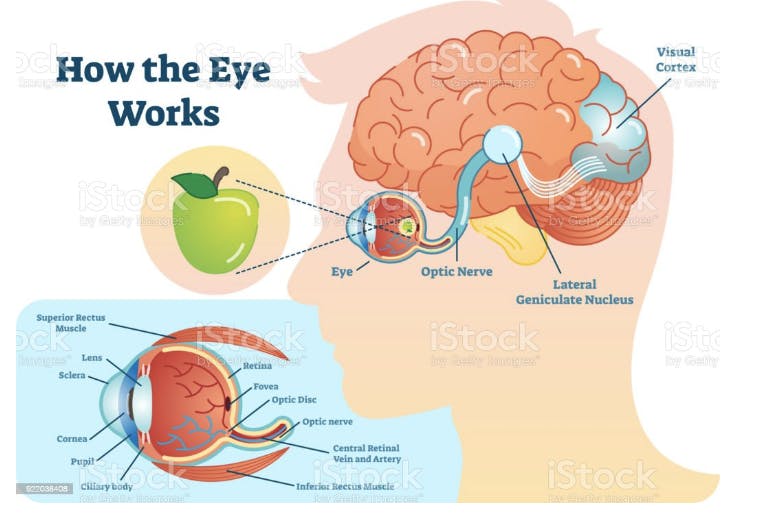TL;DR Science: Vision and the Optic Nerve
By Srishti S.
July 14, 2023 · 4 minute read
Vision forms the basis for our everyday lives; after all, almost everything we do – from studying to taking walks on the beach – depends on our ability to see. We even “eat with our eyes” before tasting our favorite foods! How is it that we are able to see the world around us, and where does the brain come into play? What conditions can hinder that ability? Let’s learn all that and more by exploring one of the most integral parts of the visual system: the optic nerve.
Eye Anatomy
To understand how we are able to see our surroundings with such precision, we have to go on a journey from the front of the eye all the way to the brain. Refer to the picture below to get a better understanding of the anatomy discussed:

We are able to see objects in front of us because of the light that reflects off those objects. This light enters through the cornea, the front-most part of the eye. The light bends and continues through the pupil, which changes in size depending on the light’s intensity.
The light continues on to the lens, the area behind the pupil that changes its shape accordingly and bends light a second time to provide for maximum visual clarity. Because the initial light has been bent twice at this point, the resulting image would be upside down and backwards – if not for the optic nerve! (We’ll touch on this later.)
The light travels to the back of the eye through the vitreous (a clear, gel-like substance) and eventually reaches the retina. The retina is especially important because it is lined with special nerves called photoreceptors that convert light into electrical impulses; these photoreceptors are called rods and cones, and they play an important role in visualizing brightness and color. The light is then focused on a specific part of the retina called the focal point.
Note: Though the light is spread throughout the retina, the goal is to get the light focused exactly on the focal point; part of the reason why some people are either near-sighted or far-sighted is because the shape and size of their eye causes the light to be focused slightly off the focal point.
Now is where the magic of vision really comes into play. The electrical impulses stored in the retinal nerves start to travel through the optic nerve at the back of the eye (look at the picture above). These impulses eventually reach the occipital lobe of the brain. Because of this unique connection to the brain, the optic nerve is generally classified as part of the body’s central nervous system (CNS).
The occipital lobe is the part of the brain that processes all of this electrical stimuli and conveys it in a way that is understandable, allowing us to perceive everything from distance to color to movement. The upside down, reversed image from before is converted to the proper orientation, and it is here that our surroundings start to make visual sense! The occipital lobe even has properties that allow it to store and recognize familiar images, including objects and faces of people you’ve met before!
Conditions
Of course, there are several eye conditions that can disrupt this intricate process.
Glaucoma, for example, is the result of increasing eye pressure due to excess fluids in the eye; this can damage the optic nerve and affect the transmission of electrical impulses to the brain. This usually occurs in older adults, but 16-year-olds can sometimes have their pressures taken during their annual eye check-ups, just in case.
Congenital eye disorders that affect the size and/or effectiveness of the optic nerve are not uncommon among children, as well. However, it is important to note that the size of the optic nerve is different among different backgrounds, ethnicities, and hereditary lines. For example, having a large optic nerve by birth is not a cause for concern; it’s oftentimes completely normal! However, drastic changes or gradual abnormalities are often monitored by eye specialists, as prevention is always better than cure!
TL;DR:
The eye is an incredibly complex organ that allows us to experience the world around us. It’s amazing how light is processed in so many different ways from the cornea all the way to the brain. There are so many unique structures within the scope of the eye itself, but we must give credit to the optic nerve that serves as a transition point to the brain and “corrects” our perception of our surroundings.
Here is a brief yet informative video about the optic nerve if you want to learn more!
https://www.youtube.com/watch?v=ymImMzFS1xo
Sources:
https://my.clevelandclinic.org/health/body/22261-optic-nerve
https://www.optometrists.org/general-practice-optometry/guide-to-eye-health/how-does-the-eye-work/
Image Sources:
Did you enjoy this article?
About The Author
Srishti Swaminathan is a rising high school junior interested in STEM and writing. She enjoys reading, listening to music, and watching movies. If you have any comments or questions regarding this article, feel free to contact her at srishti@sciteens.org.